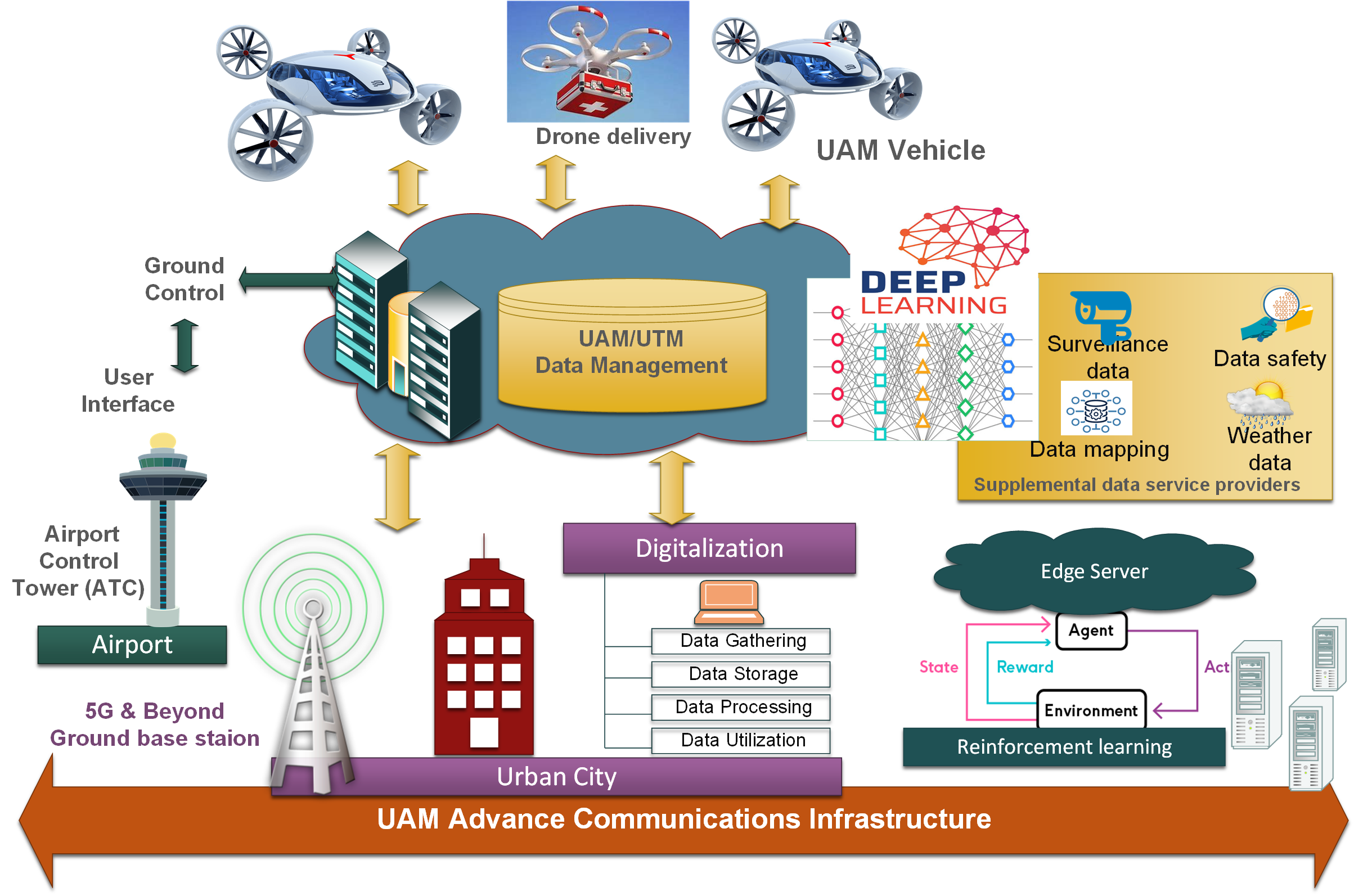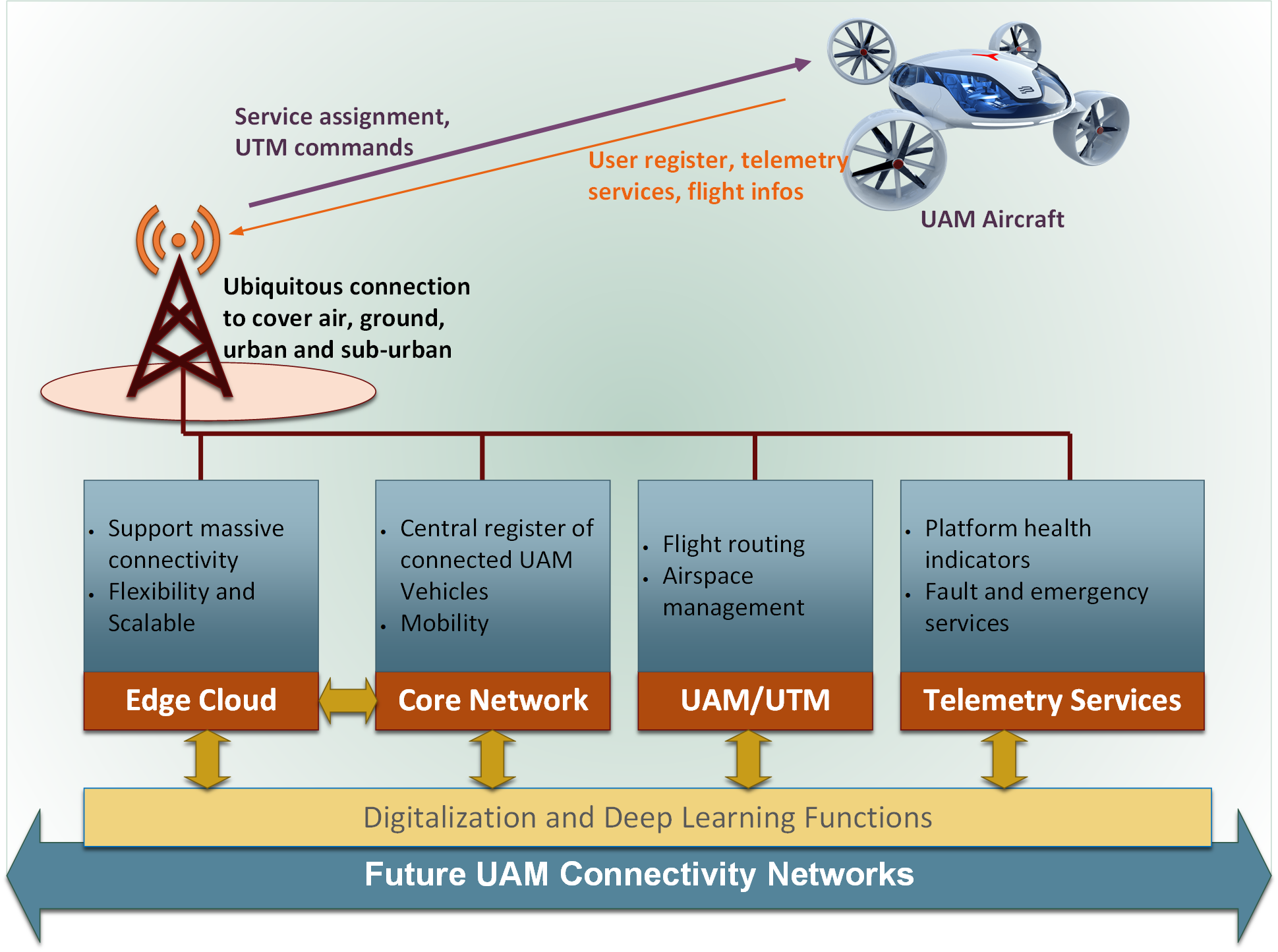Connectivity for Air Mobility Transportation in Future Networks
Saba Al-Rubaye and Antonios Tsourdos, School of Aerospace, Transport and Manufacturing, Cranfield University, UK
IEEE Future Networks Tech Focus, Issue 12, April 2021
Abstract
To enhance safety and efficiency for commercial urban air mobility (UAM) aircraft operation, it is considered that a fully automated data management system will be beneficial to accelerate the widespread commercial deployment of unmanned aircraft systems (UAS). Such operations need to be accommodated in the current national and international controlled airspace as well as in uncontrolled airspace that is currently rarely used for aircraft operations. However, the UAS aircraft demands for ultra-low latency connectivity and reliable operation, especially in city domains is expected to growth to meet the aviation business market. The potential use case presents in this article of six-generation (6G) technology powered by artificial intelligent techniques can contribution to safe and reliable integration of operation services. The new architecture design can facilitate any kind of routine mission in all types of airspace. This can be a roadmap to adopt new aerospace architecture to more sophisticated solutions which offer greater scalability and robust connectivity.
1. Introduction
The future flight is evolving with the arrival of commercial UAS aircraft that provides various services including drone delivery, surveillance of buildings and roads, or even relaying signals for cellular networks. There is an increased recognition of the need to connect remote UAS, to ensure safe and effective operation to the digital economy. The UAS aircraft will operate in lower altitudes within the coverage domains of ground base stations, which required certain features to support regular data transmission along with navigational information required for routing UAS between flying corridors. For UAM domain, the challenge is now being exacerbated by the increased demand for data services, and the more limited range in a terrestrial environment of the higher frequency carriers required for the vertical take-off and landing (eVTOL) systems that provide high user data rates, and the consequential increased infrastructure costs and difficulty of finding suitable locations for deployment. The 6G technology approach offers some of the advantages to the new aerospace architecture by taking advantage of the latest evolutions in fifth generation (5G) end-to-end slicing, artificial intelligence (AI) and Internet-of-Things (IoT) [1]. The 5G operate in two frequency ranges (FRs): FR1 that includes the sub-6 GHz radio frequencies and FR2 that represents the millimetre (mm)-waves operating at higher frequencies between 24.25 - 52.6 GHz. This wide range of radio channels that is most likely to expand into higher bands over the 6G, provided other features, will become the basic infrastructure components for new network that connects UAS and hopefully support the management of their operations.
The UAM simply leverages the unmanned aircraft system into new disciplines that are more associated with human daily life but also requires to fly within crowded urban cities [2]. In wide deployments, UAM poses major safety and security threats unless complemented with intelligent connectivity system that carries UAS acquired data, routing commands, and UAS platform status messages. The state of art for a talented network solution will also require integrating unmanned traffic management (UTM) to manage UAS routing and air transition operations. Tailoring back to network design, capturing data and real-time processing of various parameters become the key factors for over-the-top (OTT) services for UAS-related applications to make decisions, especially UTM. By addressing those complex issues progressively over the coming years, the commercialisation of automated flights and beyond visual line of sight (BVLOS) operations will become less restricted and safe to use at a larger scale. This will open-up the true art of the possible for UAS fleets, particularly in the medical, logistics, energy, and agricultural sectors. This will then enable a shift away from the same repetitive policy making discussions that is most likely to happen at the first deployments towards more proactive decisions that take into account telemetry indicators of both UAS and network platforms as well as tactical changes in UAM traffic status.
In the near future, UAM networks will tremendously evolved driven by a sharp increase in user connected machines, data demands and supported services. Designing a compatible network infrastructure that supports traffic demands in a cost-effective fashion will be always a subject to network generation. A main challenge in providing connectivity to the low flying UASs through future 6G network arises from increased interference. Dense network infrastructure and concurrent transmissions to ground-based users and UASs are the main source for higher noise levels, especially on the downlink. In addition, UASs could also overload the network with massive data streams with limited channel bandwidth. One of the solutions may be drives much tighter frequency reuse and wider channel deployment [3]. Therefore, it is necessary to define the equivalent of hexagonal cellular domain shapes for UAS air layer or what could be the air coverage domains for ground base stations.
2. Integrated UAM and 6G Technology
The existing UTM platforms can support the planning and executing of UAS operations with full compliance to the applicable legislation. It allows the authorities to monitor, track and manage UAS activities within their airspace. UTM services in urban domains are challenged by the highly dynamic topology of airspace, different speeds and sizes of UAS, and heterogeneous quality of service (QoS) requirements (e.g., downlink/uplink, latency, etc.). Therefore, integrating UTM platform into the core/edge data centres of 6G networks will significantly reduce the time delays experienced when data transferred between those systems separately. It will also allow to combine UAS telemetry data with routing information to improve safety and reliability of UAS operations. This integration will solve key challenges faced by content-aware cellular connected aerial platforms including virtualised radio resource sharing and management between aerial platforms and terrestrial systems. This happen due to the fact that both UTM and radio management services are processed concurrently by the same hosting platforms. Obviously, this requires migrating UAM components into virtual automated applications that comply with cloudification concepts and cloud-based network segmentation. The integration of UTM architecture with 6G cellular networks seems to be a mandatory technical requirement a head of deploying UASs at urban areas. Therefore, UAS services may just become a new service slices within 6G to share database required for done identification, localization and performance management.
The 6G trend is expected to leverage current communication technologies using edge computing to visible light as a future solution that can address UAS connectivity problems by providing elastic resources and reliable services to the end users. The proposed high-level diagram shown in Figure 1 does not prevent the existence of more than one UTM, however it assumes that should such operators exist, then all UTM services will coordinate and distribute both constraints and information. It is considered that each of the UAM/UAV operators or systems are independently responsible for the data exchange internally to their own systems, for instance to ensure that appropriate connectivity is maintained between ‘pilots’, operational eVTOL platforms, infrastructure and systems. The 6G communication systems can provide such services are transparent to the UAM/UTM architecture to ensuring a safety. The minimum UAM service portfolio shall include the static and dynamic constraints associated with the geographic areas of exclusion, as specified by the other airspace users, as provided by the air navigation service provider (ANSP). The UTM data management system based 6G platform will help to disseminate information provided by eVTOL or UAS operators and users to other organisations authorised to receive such information, to the level approved for dissemination.
 Figure 1. Air mobility operation architecture in 6G paradigm
Figure 1. Air mobility operation architecture in 6G paradigm
Regarding the UAM ecosystem, there are several basic data sources that UTM will need to integrate to ensure safe and efficient movement of the UAS. The data could originate from 6G radio access network, UAS service providers, UAS fleets, weather forecasting, surveillance systems, etc. This information is further processed through artificial intelligence (AI) to determine the exact UAS location and relevant traffic managements for that airspace. The UAM service consists of several unmanned systems that can be remotely commanded to perform several tasks including site monitoring, personal security, internet range extension, etc. Requesting a certain service from any UAM platform will be enabled via centralised register that offer such services and identify them to local provider. Although some UAS may support multi-service types and could have differed registers within the database, some will be only associated with one type of services or even owned/operated by one service provider. To this end, services can be classified as separated data repositories that employ their own data processing and storage capabilities. The assignment scheme of services will be highly associated with connectivity model and control commands. A data-driven decision-making approach can be enabled via deep learning data analytics across all the monitored constraints thereby developing a more automated approach for service planning and management, both at strategic and tactical levels. On the other hand, the future 6G networks need to be more focused on using reinforcement learning to understand and learn how to interact with UASs considering requested services and connectivity factors.
3. Autonomy at the Edge
The enrichment of 6G technology will employ sophisticated diagnose and dynamic processing of various events by AI and machine learning, where both can bring unprecedented communication services and experiences to users. The need for intelligent communication network that could support the demand for a higher data rate sufficiently fostered increased interest in the development of drone technology [4]. The AI will be a key component of processing any request for 6G connectivity. This is applicable for future UAM 6G network that employs AI based technology for managing intelligent and ubiquitous connectivity between ground base station and UAS profile through the core network, UTM commands, and platform monitoring through telemetry services, as shown in Figure 2. The deep machine learning provides the prediction mechanism over the entire range of constraints that originate from different data sources. The predications are combined with all real-time data to conduct the necessary adaptions in 6G services, whenever needed. This network design will produce a variety of composable outputs that trigger network optimisation and decision actions. This architecture will also allow 6G networks to provide both real-time analysis and future forensic assessment of connectivity that also reflected in more reliable UAS operations.
 Figure 2. The trend of 6G based AI for future UAM Connectivity
Figure 2. The trend of 6G based AI for future UAM Connectivity
The AI-assisted decisions can be seen in link capacity adaptations to accommodate real-time voice and video transmission from aerial platforms, scalable virtual components that process various requests, changes to flight routes, and notifications on future occurrence of platform alarms. This means that future 6G networks can provide real and futuristic KPIs that support reliable and sophisticated UAS services in urban domains. This article shows how deep learning model explain ability to manage connectivity and flight systems by factoring functional and predicated analysis into network management decisions.
4. Conclusion
This article provided a future flight vision of UAM 6G networks. A high-level architecture that integrates 6G networks with UTM was proposed along with AI-based data processing components. Adopting AI in the UAM 6G formwork requires that multiple applications to operate in real-time on connected virtualization platform that conforms with strict end-to-end KPI requirements of ultra-reliable, ultra-low latency, and massive data processing capabilities. 6G network is shown to bring several benefits to drone technologies regarding the connectivity infrastructure interacts with thousands of UAS and flying taxis through data management system maintains high standards to protect human life. Although these tactics bring several advantages, there are still other challenges and requirement that need to be adopted for UAM to accomplish a real-life capability of such UAS applications to bring connection reliability, network availability, energy efficiency, and security.
Acknowledgments
This research was supported by the grants received from Innovation UK under the programme of Future Flight Challenge- Phase2 (Grants No# 71017, Grant No# 75528 and Grant No#74842)
References
- Tomkos, D. Klonidis, E. Pikasis and S. Theodoridis, "Toward the 6G Network Era: Opportunities and Challenges," in IT Professional, vol. 22, no. 1, pp. 34-38, 1 Jan.-Feb. 2020
- C. Reiche, C. McGillen, J. Siegel and F. Brody, "Are We Ready to Weather Urban Air Mobility (UAM)," 2019 Integrated Communications, Navigation and Surveillance Conference (ICNS), Herndon, VA, USA, 2019, pp. 1-7.
- W. Saad, M. Bennis and M. Chen, "A Vision of 6G Wireless Systems: Applications, Trends, Technologies, and Open Research Problems," in IEEE Network, vol. 34, no. 3, pp. 134-142, May/June 2020,
- T. Han, I. de L. Ribeiro, N. Magaia, J. Preto, A. H. Fontes N. Segundo, A. Roberto L. de Macêdo, K. Muhammad, and V. Hugo C. de Albuquerque., "Emerging Drone Trends for Blockchain-Based 5G Networks: Open Issues and Future Perspectives," in IEEE Network, vol. 35, no. 1, pp. 38-43, February 2021.
 Saba Al-Rubaye received her Ph.D. degree in Electrical and Electronic Engineering (Telecommunications) from Brunel University London. Currently, she is working as a Senior Lecturer and leading connected system research and development in DARTeC at Cranfield University. Her main research interests focus on air mobility communications, autonomous system, aircraft connectivity, and 5G/6G systems. She is a Chartered Engineer (CEng) and Senior Member of IEEE.
Saba Al-Rubaye received her Ph.D. degree in Electrical and Electronic Engineering (Telecommunications) from Brunel University London. Currently, she is working as a Senior Lecturer and leading connected system research and development in DARTeC at Cranfield University. Her main research interests focus on air mobility communications, autonomous system, aircraft connectivity, and 5G/6G systems. She is a Chartered Engineer (CEng) and Senior Member of IEEE.
 Antonios Tsourdos received his Ph.D. on nonlinear robust missile autopilot design and analysis from Cranfield University. He is currently a Professor in Autonomous Systems and Control. He is the head of Autonomous and Cyber-Physical Systems Centre and Director of Research at Cranfield. He has extensive expertise in both unmanned and autonomous vehicles as well as networked systems. He conducts basic and applied research in the fields of guidance, control and navigation as well as research on future flight.
Antonios Tsourdos received his Ph.D. on nonlinear robust missile autopilot design and analysis from Cranfield University. He is currently a Professor in Autonomous Systems and Control. He is the head of Autonomous and Cyber-Physical Systems Centre and Director of Research at Cranfield. He has extensive expertise in both unmanned and autonomous vehicles as well as networked systems. He conducts basic and applied research in the fields of guidance, control and navigation as well as research on future flight.
Subscribe to Tech Focus
Join our IEEE Future Networks Technical Community and receive IEEE Future NetworksTech Focus delivered to your email.
Article Contributions Welcome
Submit Manuscript via Track Chair
Author guidelines can be found here.
Other Future Networks Publications
IEEE Future Networks Tech Focus Editorial Board
Rod Waterhouse, Editor-in-Chief
Mithun Mukherjee, Managing Editor
Imran Shafique Ansari
Anwer Al-Dulaimi
Stefano Buzzi
Yunlong Cai
Zhi Ning Chen
Panagiotis Demestichas
Ashutosh Dutta
Yang Hao
Gerry Hayes
Chih-Lin I
James Irvine
Meng Lu
Amine Maaref
Thas Nirmalathas
Sen Wang
Shugong Xu
Haijun Zhang
Glaucio Haroldo Silva de Carvalho

